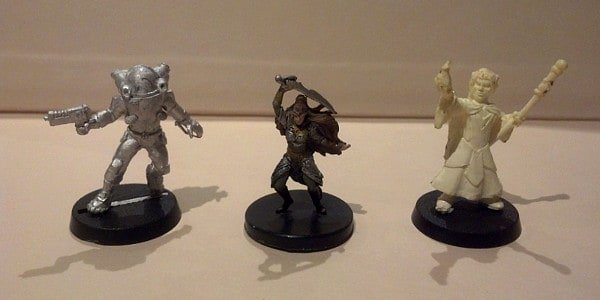
Pendix here, chief (and only) sculptor of Ex Manus Studios. This week I wanted to talk about the materials we (and by we, I mean the industry) make miniatures out of. This is a subject I’ve seen discussed a lot online, and with my love of miniatures & background in manufacturing, I thought it was time I threw my own 2 cents in.
The question is often posed: ‘what is the best material to make miniatures out of? Plastic, metal, or resin?’ Now, Ex Manus Studios miniatures are made out of a lead alloy, so you might expect me to take the ‘metal is best’ side. But not so fast; my position is that all the materials are good, but in different ways, making the best material to use dependent on desired use and production constraints.
So let’s drill down, and take a look at each material’s strengths, weaknesses, and best applications.
Metal
Whether it is a lead alloy, or a variant of ‘white metal’, metal miniatures are a common sight on gaming table tops. For the collector; metal minis are the most robust type of miniature; they hold detail well, and will usually bend before breaking, making repairs often a simple matter of bending things back, and re-painting.
Unfortunately they are heavy, and hard to work with when making conversions, or even regular assembly of multi-part miniatures. A situation only exacerbated by larger miniature which usually have more parts, and those parts are heavier.
For the producer of miniatures, they have the lowest cost of entry, with the moulds being less expensive and easier to make than for plastic miniatures. The typical spin casting process is also easier than the casting processes used for resin.
Verdict
Metal miniatures are best for small, typically one-piece miniatures, produced by smaller operations, in relatively short runs. Excellent for the display collector, RPG player and miniature painting enthusiast.
Plastic
Plastic miniatures are less robust than metal, but much easier to work with when constructing and converting, making it good for miniatures of all sizes as well as vehicle and scenery pieces. The cost of the material per miniature is very small indeed, so plastic miniatures are usually very inexpensive, which is good for wargames and the like, that need a large number of miniatures to play.
Plastic miniatures are produced via Injection Moulding, a process that requires moulds cut (or ‘machined’) from solid blocks of stainless steel. This is an expensive process (at least by comparison) but casting itself is cheep and largely automated. This means plastic miniatures are only cost effective, when a (very) large number are produced (to spread out the initial costs).
Verdict
Plastic miniatures are great for all types of miniatures, but particularly larger pieces. It should only be embraced by medium to large operations that can be confident in selling large volumes of product. Good for all types of gamers and collectors, but at its best for tabletop wargaming.
Resin
Resin, as a material for miniatures, is relatively new, hitting the industry only in the last 5 or so years. While similar in many respects to plastic (though perhaps more fragile), resin is often seen as being a compromise between the drawbacks of metal vs plastic, as it does not require the high initial cost of plastic, but is also light weight, and easy to work with.
However there are significant challenges that the industry is still grappling with. Most resin casting process struggle to ensure quality castings with every pour (as the chemical reaction in the setting resin creates bubbles after pour is finished), and the process is more labour intensive than either metal or plastic, which can push up the price of production per miniature.
There are a number of different players in the industry trying different process or chemicals to solve these problems, and there is certainly enough evidence of success (with some truly spectacular quality resin miniatures to be found) that resin is not going anywhere any time soon.
Verdict
Resin is an excellent choice for collectors who can find the quality and gamers who are ok with the fragility. For producers, resin allowing for a wide variety of miniatures, vehicles and scenery, with a low cost to entry, and allowing for smaller runs than plastic. However, this is only true if they can address the challenges of the process.
Well, that’s it. Feel free to leave any comments, questions or (and I’m opening this up for the first time) to suggest future topics.
– Pendix Out
